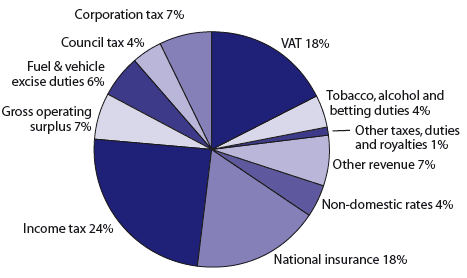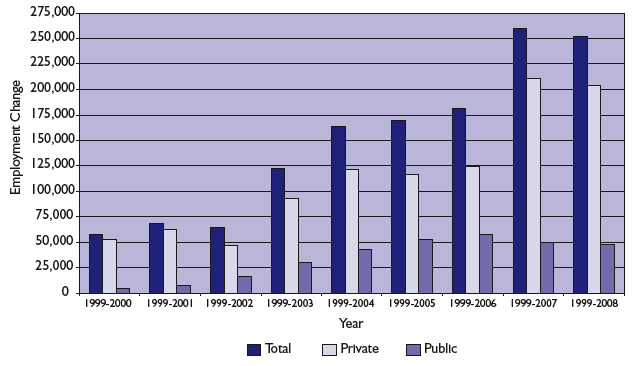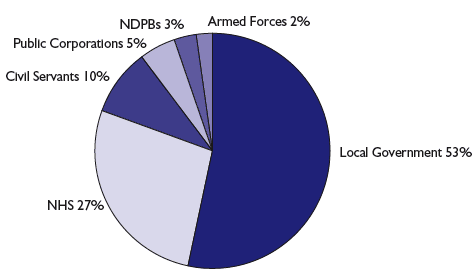Scottish Economic Statistics 2008
This is the ninth edition of the annual publication Scottish Economic Statistics, which is produced by statisticians in the Scottish Government.
B6 chapter six: Public Sector
Public Sector Accounts
The amount of money raised from taxes and other sources in Scotland and the amount of government expenditure for Scotland is estimated in the annual Government Expenditure and Revenue Scotland ( GERS) exercise. GERS 2006-07 is the first edition following a full statistical review of methodologies and data sources which was conducted between January 2007 and the publication of the report. The timetable for the GERS publications has been brought forward by six months and the results published in line with the UK Public Sector Finances statistics.
Full details of the methodologies adopted and the review can be found in the GERS 2006-07 publication which is available at: http://www.scotland.gov.uk/News/Releases/2008/06/20102910.
Public Sector Receipts
Most UK taxes are collected centrally, and so information on the source region is often unavailable. In these cases, proxies are used in order to estimate the amounts of taxes collected from Scotland, although there are several practical and theoretical difficulties that arise in doing this. It is estimated, however, that excluding North Sea Revenue, Scotland contributed £42.4 billion in the financial year 2006-07, which amounted to 8.3 per cent of the total UK revenue excluding North Sea.
Chart 6.1 illustrates the proportions of the estimated total revenue originating from various sources. It can be seen from Table 6.1 that compared with the UK as a whole, Scotland pays more local taxes relative to its population, but contributes less to income tax revenue.
Chart 6.1: Estimated government revenue from Scotland, by source 2006-07

Source: Government Expenditure and Revenue Scotland 2006-2007, Scottish Government
Table 6.2 presents a summary of Local Authority revenue and capital income and expenditure for 2006-07 from the Scottish Local Government Finance Statistics 2006-07 publication. The Scottish Local Authorities collected a total of £3.7 billion in Council Tax and Non-domestic rates in 2006-07. Table 6.3 summarises Council Tax by Local Authority for 2007.
Government Expenditure
The GERS report produces estimates of Total Expenditure on Services for Scotland by considering source data from the HM Treasury publication: Public Expenditure Statistical Analysis 2008 ( PESA). Expenditure which HM Treasury can directly attribute to individual regions of the UK is termed as identifiable. Other expenditure is made at the UK level and cannot be assigned directly to a particular geographical region. Defence is the main example of such "non-identifiable" expenditure. GERS adopts a number of methodologies to attribute a share of these expenditures to Scotland. For example, defence expenditure is apportioned using the population share, 8.4% for 2006-07.
Table 6.4 gives the estimates of identifiable and non-identifiable expenditure on different services in 2006-07.
Total Expenditure on Services ( TES) in Scotland estimates include both identifiable expenditure and the estimates of non-identifiable expenditure. In 2006-07, this amounted to an estimated £49.9 billion, which was 9.5 per cent of the UK total. The largest category of spending was social protection, which accounted for £16.2 billion or 32.4 per cent of total spending.
Table 6.5 details Local Authority current expenditure for 2006-07.
In GERS, three estimates of Scotland's public sector accounts are presented, (i) an estimate excluding North Sea Revenue, (ii) an estimate based on the per capita share of North Sea Revenue and (iii) an estimate based on an illustrative geographical share of North Sea revenue. Table 6.7 provides a full breakdown of the current and capital budgets for Scotland from 2002-03 to 2006-07.
Public Sector Employment
The quarterly series of Public Sector Employment in Scotland provides official estimates of public sector employment, which are consistent with the UK series published quarterly by the Office for National Statistics ( ONS). The series is published in the months of March, June, September and December with data relating to the previous quarter. A full quarterly series back to 1999 Q1 is available. The latest publication available can be found at: http://www.scotland.gov.uk/Publications/2008/09/17083742/0.
The series is based on the National Accounts definition of public sector, more information on which can be found at: http://www.statistics.gov.uk/CCI/SearchRes.asp?term=ma23. This definition does not include those employed as GPs or Dentists, as they are defined as self-employed and are in the private sector. It also excludes employment in Higher Education, which is in the Non-Profit Institutions Serving Households sector.
The data in the series are taken from Departmental returns (including the Armed Forces), a Survey of Local Government in Scotland and surveys of Public Corporations and Non-Departmental Public Bodies carried out by ONS and the Scottish Government. Further details of Local Government Employment Statistics in Scotland can be found at: http://www.scotland.gov.uk/Topics/Statistics/Browse/Labour-Market/JointStaffingWatchSurvey .
Public/Private Sector
Estimates of the split between those employed in the public and private sectors have in the past been sourced from the Labour Force Survey ( LFS). However, ONS, who carry out the survey, acknowledge that the LFS tends to over-estimate numbers working in the public sector. Using the new quarterly public sector employment estimates, a more accurate split between public and private sector employment can now be produced. Private sector employment is now calculated as total employment taken from the Labour Force Survey (not seasonally adjusted) minus the estimate for public sector employment. For 2008 Q2, 22.7 per cent of employees were employed in the public sector and 77.3 per cent in the private sector.
Between 1999 Q2 and 2008 Q2, total employment in Scotland increased by 252,000. The public sector accounted for 19.2 per cent of this increase and the private sector accounted for 80.8 per cent. Chart 6.2 shows the changes in public and private sector employment in Scotland since 1999.
Components of Public Sector Employment
Table 6.6 provides a breakdown of the public sector employment estimate for 2008 Q2 into the component parts. This data is for Full Time Equivalents ( FTE) which provides a better indicator of total labour input than a simple headcount. Local Government, which employs teachers, police, social work and fire services, employs 256,000 people and accounts for 52.7 per cent of public sector employment. The National Health Service ( NHS) is the next largest public sector employer, employing 132,100, and accounting for 27.1 per cent of the public sector. The Civil Service accounts for 9.4 per cent, Public Corporations 4.6 per cent and Non-Departmental Public Bodies 3.0 per cent of public sector employment. Armed forces accounts for 2.5 per cent of the public sector. Chart 6.3 illustrates the component share of public sector employment in Scotland.
Chart 6.2: Changes in public and private sector employment since 1999

Source: Public Sector Employment in Scotland
Chart 6.3: Components of public sector in Scotland, 2008 Q2

Source: Public Sector Employment in Scotland Series
Note: Based on Full-Time Equivalents
There is a problem
Thanks for your feedback